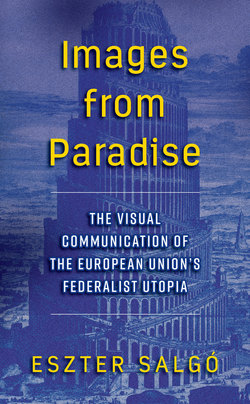Images from Paradise

Реклама. ООО «ЛитРес», ИНН: 7719571260.
Оглавление
Eszter Salgó. Images from Paradise
IMAGES FROM PARADISE
Отрывок из книги
IMAGES FROM PARADISE
Eszter Salgó
.....
In all forms of human culture (art, science, religion, myth, etc.) we find a “unity in the manifold” (Cassirer 1955: 44). A unity in the manifold can be found in politics as well: “politics is an art of unification; from many, it makes one” (Walzer 1967: 194). I will use the metaphor of the fantastic family as a symbolic representation of the European Union to unveil and explore Europeans’ deeply felt desire—the wish to find in public life the resolution, love, and wholeness that were lost; to unite what vanished, or never existed but which was intensely sought after; and to integrate what remained fragmented in private life. Especially in today’s transitional period of uncertainty, our feelings may reflect a profound yearning for an ideal family; for a father figure able to protect, create, order, and guarantee prosperity; for a mother figure who holds us in her hands, nourishes and loves us; and for a “house” where we can feel “at home.” I will portray Europe as a state of mind, visionary and real at the same time (rather than as an objective, external reality). I will explore the European integration process as a special “art of unification,” in which unification suggests people’s constant search, also in public life, for phenomena that echo the fantasized realm of wholeness, the “primal union,” that characterizes the earliest stage of life when infant and mother exist as a “primary unit,” as an “imaginary dyad”; and EU officials’ persistent urge to provide citizens with “transformational objects” (Bollas) or with a objet petit a (Lacan), which evoke the idyllic conditions of the primordial paradise.
Since ancient times, the human body, the family, and the theater have been used as traditional metaphors to imagine, construct, and describe political communities. Their meanings have transformed, but they are still among the most effective tropes. Today, European federalists make use of the family metaphor as a means to rally popular support for the project of the United States of Europe. Numerous attempts have been made to inject intimacy into the (still embryonic) European public life. There is a belief that emotions, sentiments, sensations, and fantasies can be nurtured through tropes of familial ties, such as “European family,” the “European house,” “birth,” “child,” “mother,” “father,” and “twinning,” and can serve to reinforce the feeling of community and a sense of belonging. In the family model promoted by the European Commission, top-down, often aggressive symbolic policies have been launched to prescribe not only who should be intimate with whom but also who deserves this intimacy: who can be considered a legitimate member of the European family. According to Eleni Papagaroufali, “The Commission’s extensive ‘investment’ in the normative ‘distribution of [familial] affections’ among its members, as well as its enormous interest in creating multiple microsites of intimate space is best exemplified by the institution of twinning” (2008: 73). For me, among the most important attempts to fill the emotional gap the EU suffers from would be to highlight the Commission’s portrayal of the Eurozone through the metaphor of the European family; the ECB’s decision to ornament the symbol of a united and prosperous European family, and its most beloved “child,” the euro, with the pictorial metaphor of Europe’s “mother”; the advertising campaign aimed at reinforcing these fantasies (and implicit promises) and the videos launched to prepare the act of communion that was to take place in occasion of the 2014 elections to the European Parliament.
.....